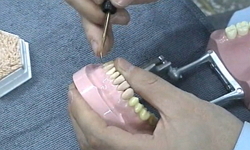A morphological study was conducted of the Korean Fimbristylis in order to clarify the taxonomical position and scientific naming among species. It was determined that anther size and style length are important characteristics for the species-level id...
http://chineseinput.net/에서 pinyin(병음)방식으로 중국어를 변환할 수 있습니다.
변환된 중국어를 복사하여 사용하시면 됩니다.
- 中文 을 입력하시려면 zhongwen을 입력하시고 space를누르시면됩니다.
- 北京 을 입력하시려면 beijing을 입력하시고 space를 누르시면 됩니다.
https://www.riss.kr/link?id=T14575867
- 저자
-
발행사항
전주: 전북대학교 일반대학원, 2017
-
학위논문사항
학위논문(박사) -- 전북대학교 일반대학원 , 생물학과 , 2017. 8
-
발행연도
2017
-
작성언어
한국어
- 주제어
-
발행국(도시)
전북특별자치도
-
기타서명
(A) Taxonomic Study of the genus Fimbristylis Vahl (Cyperaceae) in Korea
-
형태사항
vi, 210 p.: 천연색삽화; 26 cm
-
일반주기명
전북대학교 논문은 저작권에 의해 보호받습니다.
Appendix: 1. Examined Specimens of Korean Fimbristylis
지도교수: 김무열
참고문헌: p. 150-156 - 소장기관
-
0
상세조회 -
0
다운로드
부가정보
다국어 초록 (Multilingual Abstract)
Fimbristylis longispica, F. sericea, and F. stauntonii were positioned as separate taxa, without controversy. An urgent conservational strategy is required as all of these species are sparsely distributed and their natural habitats are under threat from human pressure.
Fimbristylis dipsacea var. verrucifera and F. complanata var. exaltata varied only slightly from typical species, whereas F. sieboldii clearly differed from the tropical species F. ferrugineae with respect to the style length and stamen size. Thus F. sieboldii is clearly an independent species.
There has long been confusion between F. littoralis and F. miliacea due to two different specimen types. We concur with Strong(2004), that F. littoralis is the legitimate name.
Although F. diphylloides and F. drizae show similarity in their appearance, F. diphylloides has leaves that are shorter than its' stem and relatively short style. In comparison, F. drizae has leaves longer than the stem and longer style. These differences have led to the conclusion that they are independent species.
F. pierotii and F. jindoensis are similar in having a long creeping rhizome, but F. pierotii has simple inflorescence, whereas F. jindoensis has compound inflorescence.
F. complanata var. exaltata resembles F. jindoensis, having similar inflorescence, but F. jindoensis has a long creeping rhizome and solitary culm, while F. complanata var. exaltata is distinguished by its' very short rhizome and tufted culm. Furthermore, the characteristics of F. jindoensis lie between F. pierotii and F. complanata var. exaltata in anther size and flowering period. Therefore these three taxa are treated as independent species.
F. tomentosa has 11-20 longitudinal rows and F. dichotoma var. dichotoma has 7-10 longitudinal rows in the surface achene patterns. In addition, two species have different anther size. Therefore these taxa is treated as different species.
According to this study, Korean Fimbristylis is classified into a total of 20 taxa, including sixteen species and four varieties.
A morphological study was conducted of the Korean Fimbristylis in order to clarify the taxonomical position and scientific naming among species. It was determined that anther size and style length are important characteristics for the species-level identification of Fimbristylis.
Fimbristylis longispica, F. sericea, and F. stauntonii were positioned as separate taxa, without controversy. An urgent conservational strategy is required as all of these species are sparsely distributed and their natural habitats are under threat from human pressure.
Fimbristylis dipsacea var. verrucifera and F. complanata var. exaltata varied only slightly from typical species, whereas F. sieboldii clearly differed from the tropical species F. ferrugineae with respect to the style length and stamen size. Thus F. sieboldii is clearly an independent species.
There has long been confusion between F. littoralis and F. miliacea due to two different specimen types. We concur with Strong(2004), that F. littoralis is the legitimate name.
Although F. diphylloides and F. drizae show similarity in their appearance, F. diphylloides has leaves that are shorter than its' stem and relatively short style. In comparison, F. drizae has leaves longer than the stem and longer style. These differences have led to the conclusion that they are independent species.
F. pierotii and F. jindoensis are similar in having a long creeping rhizome, but F. pierotii has simple inflorescence, whereas F. jindoensis has compound inflorescence.
F. complanata var. exaltata resembles F. jindoensis, having similar inflorescence, but F. jindoensis has a long creeping rhizome and solitary culm, while F. complanata var. exaltata is distinguished by its' very short rhizome and tufted culm. Furthermore, the characteristics of F. jindoensis lie between F. pierotii and F. complanata var. exaltata in anther size and flowering period. Therefore these three taxa are treated as independent species.
F. tomentosa has 11-20 longitudinal rows and F. dichotoma var. dichotoma has 7-10 longitudinal rows in the surface achene patterns. In addition, two species have different anther size. Therefore these taxa is treated as different species.
According to this study, Korean Fimbristylis is classified into a total of 20 taxa, including sixteen species and four varieties.
목차 (Table of Contents)
- Ⅰ. 서론 1
- Ⅱ. 재료 및 방법 10
- 1. 재료 10
- 2. 방법 21
- Ⅲ. 결과 26
- Ⅰ. 서론 1
- Ⅱ. 재료 및 방법 10
- 1. 재료 10
- 2. 방법 21
- Ⅲ. 결과 26
- 1. 생태학적 연구 26
- 2. 형태학적 연구 31
- 3. 하늘지기속의 기재 76
- 4. 하늘지기속 절 검색표 77
- 5. 한국산 하늘지기속(Fimbristylis)의 종 검색표 78
- 6. 분류군의 기재 81
- Ⅳ. 고찰 142
- Ⅴ. 요약 148
- Ⅵ. 참고문헌 150












